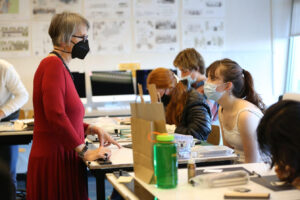It’s 1989. Lick-Wilmerding High School does not have an official Architecture class, only a similar class called Drafting & Design. The previous teacher of the class, George Tyrogalas, has left the position. As a result, Goranka Poljak-Hoy enters her first year of teaching at LWHS with no guide, no blueprints and no trace of what the class had previously been like.
33 years later, the Architecture classes have become some of the most beloved and popular classes amongst LWHS students. How did Drafting & Design evolve into the present-day Architecture program, and what are the experiences of the students currently in the program?
As of the 2022-2023 school year, Architecture is an extremely sought-after course, with 41 students currently in two sections of the program. However, when Poljak-Hoy first began teaching the class in 1989, the interest level wasn’t nearly as high. There were many years of trial and error in the curriculum, as Poljak-Hoy had to design the course from the ground up.
“I basically started with what many architecture schools do, even today, which is a lot of abstract little practice projects about architectural composition. The class was very small in the beginning, and kids were kind of interested but not super excited about it,” she said.
Then, in 1990, LWHS Architecture student Christian de Brer ’90 won first place at the American Institute of Architects high school competition for “best overall design and model” with his design of a bed and breakfast. It was then that Poljak-Hoy realized the true potential of her students when they are passionate about their designs. “I’ve learned that as much as abstract projects can be really important in evolution and architectural composition, for [high school students] having something that’s much more exact and relatable, like models, is actually better,” she said. “So, I dramatically changed my program.”
Poljak-Hoy taught both the Drafting & Design class and the Architecture class until 2006, when Drafting & Design was incorporated into the current Design & Technology class. The Drafting & Design class designed small structures such as doghouses and birdhouses, while the Architecture class designed more complex structures such as country houses, meditation sanctuaries and art galleries.
Yakuh Askew ’92 took the Drafting & Design and Architecture classes during his time at LWHS. In 2005, he founded the architectural design studio Yakuh Askew (Y.A.) Studio, located in the Mission District of San Francisco. “When I started [at LWHS], there was not an Architecture program, there was a drafting program. It was taught by the professor prior to Goranka, and it was really focused on mechanical drafting. We did things like draw screws and nuts and bolts — kind of weird abstract things like that. Then, in my junior year, Goranka came in and started doing Architecture classes,” he said.
In addition to being a student of Poljak-Hoy’s, Askew had the opportunity to work with her in 2001 while on a jury to select the architects who would design the new mechanical shops classes at LWHS. He sat on the jury as the professional while Poljak-Hoy was on the jury as a faculty member. “That was a really rewarding experience, to work with her as a peer,” Askew said.
One unique factor of the LWHS Architecture program is that it is built into all students’ curriculum. Every student is required to take Architecture during their (also required) Contemporary Media and Arts (CMA) class in 9th grade, and from there, students can choose to pursue Architecture as an elective. The Architecture program advances to Architecture 3 if students choose to take the elective for all three following years. Students are creatively challenged through a multitude of different projects, such as designing a mobile home, a pavilion and a houseboat.
Architecture is typically a new class to every student, making it unique in that everyone generally begins with the same level of previous knowledge — none. “They all come with a clean slate. I don’t get students who have done architecture before, and I love supporting them to the place where they feel that they’re really growing or creating things of value,” Poljak-Hoy said.

photo courtesy of Vidigami
Briana Mancuso ’25 is a current Architecture 1 student and never expected to become so passionate about the subject before coming to LWHS. “Before going to Lick, architecture wasn’t even on my radar. I felt like architecture was the dream career that other people get to do, but that I didn’t really have access to,” she said. “It just felt so far out that I never even saw myself pursuing it until I took a quarter of that class in CMA. And I realized that it was definitely something that I could pursue.”
Due to the intricate nature of architectural models and structures, the Architecture course at LWHS is known to be extremely rigorous and time-consuming. The time it takes students to complete homework can range from anywhere between thirty minutes to several hours.
Poljak-Hoy hopes that students are able to complete their work within the allotted time given each night, but also acknowledges that students often have difficulty stopping if they are not satisfied with their work. “I would hate to tell my students they can’t do something. I know for myself, I want to be proud of what I produced,” she said. “But I also do know that sometimes it takes longer than the homework time. I like to respect the school policy, but I also don’t know how to tell my students not to be happy with their project.”
It can be especially challenging to find a balance with the amount of time spent on homework when students feel the need to perfect their models and sketches. “Time management has been a challenge because personally I am a perfectionist, which means I actually would not turn in work that I’m not at least ninety percent satisfied with. For me, being one hundred percent satisfied isn’t possible,” Sabrina Zhang ’24 said, a current Architecture 2 student.
Even though the time commitment of the Architecture course is widely acknowledged, large numbers of students continue to be a part of the program because of a genuine love for the work that they do. “I think that’s what the Architecture program is synonymous with, everyone talks about how much work there is, but I’ve also heard how amazing it is. Everyone who’s done it has been amazed by the teaching and the level of experience you get,” said Mancuso.
Lance Cumberland ’24, a current Architecture 2 student, acknowledges the sacrifices he has made for the class. “I had to drop a few Honors courses to be able to manage the course load, and I’m perfectly happy where I am now. If I didn’t drop those Honors courses, I’d be way too overwhelmed and wouldn’t be able to spend as much time as I want on Architecture,” he said.
Poljak-Hoy believes that while perfectionism can be the reason behind the amount of time students spend on homework, it sometimes goes deeper than that. “It’s really about trusting your voice. Standing for your own work. You want to own it,” she said.
The LWHS Architecture program also interweaves real-world issues into the curriculum, such as the environmental impact of architecture. “We look at a lot of different architects who work in so many different areas — out of country, out of state…and they work with sustainable materials finding what’s best for their community,” said Amaya Johnson ’24, a current Architecture 1 student.
Thinking in terms of socially responsible architecture can also factor into students’ designs. Students study marine policies and must design residencies or public spaces within those parameters. Additionally, students study site and intention, and try to reduce energy uses with their designs.
Past Architecture students have had opportunities to apply their learned skills to the real-world, such as the LWHS annual trip to Senegal (pre-COVID) that allowed students to contribute to building structures and schools. For Askew, the real-world applications of working in the architecture field has been one of the most rewarding parts of his professional career. “We do a lot of affordable housing. During the opening days, we meet the residents who have moved into their new homes and hear them share how transformative it is to get into permanent supportive housing and have a long-term stable situation. It’s really good to hear how appreciative they are of the projects we do,” he said.
The LWHS Architecture program has created a pipeline for students who intend to pursue architecture as a career. Approximately 150 students have gone to architecture school after LWHS. Some students have pursued further architecture opportunities, such as Mancuso, who will be participating in an architecture mentorship with the Sacramento-based Architecture Engineering Construction (ACE) Mentor Program in the second semester of the 2022-2023 school year.
Even if students choose not to pursue architecture as a career, many elements of the study are still extremely valuable for various career paths and classes. “Architecture could fit under so many categories. It’s an art class and it’s a math class; there’s a lot of measurements and three-dimensional arrangements. In a way, architecture reminds me a lot of poetry,” Zhang said. “It’s like free-formatted expression, but there is also a level of structure that holds it all together.”
Architecture at LWHS has been constantly evolving throughout the past few decades, but ultimately, the students within the program remain as its focus. “I am endlessly inspired by my students…I love the joy they have when they succeed in something and accomplish something that they never thought they could,” Poljak-Hoy said. “I love my job, and I love my students, and I am so grateful.”






